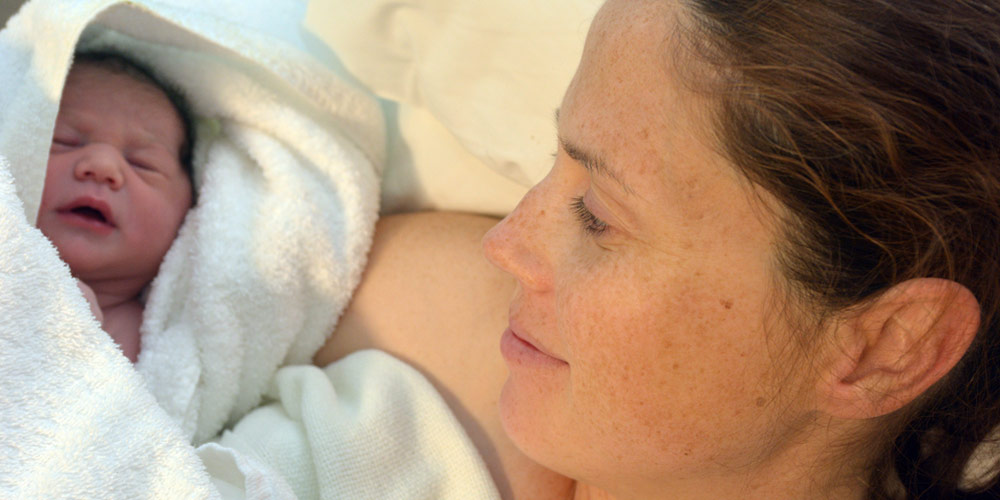What is Mindful Birthing?

Walking outside on a warm spring day, my insides constricted and pain radiated across my lower back. I closed my eyes and focused on the humid air as it made its way through my nostrils to the walls of my expanding rib-cage. I felt the sun heating my face and the breeze on my skin. I noted birds chirping, then a car purring by. I was using mindfulness meditation to help me through my labor and delivery without pain medication.
During pregnancy, I searched for a method that would help me achieve the unmedicated birth I wanted. I wasn’t convinced that contractions are merely “surges” of energy, or that the ancient wisdom of my body would allow me to experience euphoria instead of pain. I didn’t trust I could imagine myself on a beach while my insides tightened with overwhelming force—surely other pregnant women have felt similarly? I wanted a way to deal with the reality of childbirth, and Mindful Birthing by Nancy Bardacke, CNM, founding director of the Mindfulness-Based Childbirth and Parenting (MBCP) Program, was my answer.
Mindful birthing doesn’t deny pain as part of the experience (unlike some schools of thought around alternative techniques, such as hypnobirthing); rather, it provides Buddhism-based mindfulness meditation techniques for dealing with pain one moment at a time. It is one of a few birth preparations that you can—and must—practice before labor.
Mindfulness meditation gives you tools, like paying attention to breathing or focusing on the sensations in your body, that help keep you in the present moment. By practicing these tools both formally in meditation and informally throughout the day, you become better at staying in the moment. It can seem difficult at first—yes, your mind will wander—but with practice it becomes easier.
How Mindful Birthing was Born
Mindful birthing is an adaptation of the Mindfulness-Based Stress Reduction (MBSR), a program started in 1979 by Jon Kabat-Zinn, PhD, at the University of Massachusetts Medical School to help patients in a healthcare setting cope with pain.
Since then, hundreds of research studies have shown that mindfulness-based programs and guided meditations alleviate depression, anxiety, stress, pain and more.
Bardacke discovered Buddhism-based meditation for herself in the early 1980s. She longed for a way to share the practices with her midwifery patients, but it wasn’t until she met Kabat-Zinn at a retreat in 1994 that it became clear to her how she could do it. His MBSR program “was a way to make meditation practices accessible in a secular context, without … the religious context,” Bardacke says.
After adapting the MBSR program for childbirth, Bardacke has taught more than 1,400 expectant parents in 71 courses.
Being Mindful During Labor
Sarah McCarthy, a mom in Oakland, California, didn’t have the labor she expected. Her water broke, but it was only a slow trickle. After 24 hours of leaking amniotic fluid without going into labor, she was admitted to the hospital. For two and a half days, her doctors tried different techniques to kick-start labor, all without success. She and her husband were glad to have the tools they learned in Bardacke’s class.
“It could have been an anxiety-filled time, but it wasn’t,” McCarthy says. “My husband and I practiced [meditation]. We sat together, we played cards, and it ended up being a really nice time. I wholly credit that to the class.” Finally, doctors gave McCarthy Pitocin, leading to an intense labor that she managed without pain medication. “I was able to be in the moment and not freak out—mindfulness let that happen.”
Judy Cuneo, MD, a mom and OB/GYN at UCSF Osher Center for Integrative Medicine in San Francisco, California, is also a former student of Bardacke’s. “I wanted to do whatever I could to [give birth] without any pain medication,” Cuneo says. “I wanted to fully experience birth.”
She hails Bardacke’s class as life-changing, noting that she’s since used mindfulness every day—including during all four of her unmedicated births. Now, in addition to practicing as an OB for high-risk patients, Cuneo teaches MBCP classes.
During the intense, late stages of labor, Cuneo and McCarthy found that one of the most helpful aspects of mindfulness meditation was noticing—and even enjoying—the time between contractions. “That space between contractions was genuinely restorative,” McCarthy says.
“From a provider standpoint, something I see all the time is that women have a contraction, then stay in the contraction in their minds through the rest period,” Cuneo says. “That will totally wear you out.”
Though many who find mindful birth may be seeking a natural birth, that’s by no means a requirement. Bardacke stresses that mindful birthing is for all births, from those with an epidural to a C-section to an unplanned home birth. “MBCP preparation is not about natural childbirth or natural parenting. The paradox is that by training the mind to be in the present moment you are working with the process and actually supporting the natural physiology,” she explains. “Mindfulness doesn’t give you the birth experience you want—it gives you a way to fall in love with the birth experience you get.”

Remaining Mindful Beyond Birth
These techniques aren’t reserved for childbirth preparation and labor pain. In fact, many mothers find applications for mindful birthing practices long after their babies are born.
“Mindfulness is something I draw from every day,” Cuneo says. She points to how mindfulness has helped her in frustrating moments—“like staying balanced in the midst of a temper tantrum.” As someone who practices obstetrics, she adds, “I think I handle stress better. I feel more resilient. Just like those rest periods between contractions, I’m able to find quiet breaks in my work.”
“As a new parent, [mindfulness] is much more about being present with your baby. Children are in the present moment, so your baby is your mindfulness teacher,” Bardacke says. “Try mindful breastfeeding, mindful walking, mindful diaper-changing.” Do your best to be mindful even during mundane tasks, but cut yourself some slack when you slip up. “Try not to turn mindfulness into something to beat yourself up about,” Bardacke advises. That defeats the purpose.
With all the stories of sleepless nights, screaming babies and endless diapers, it sounded to me like some of new parenthood was a period to endure. What I discovered is that moments of wonder, joy and peace prevail, while those of frustration and anxiety come rarely and subside quickly.
I am grateful to have found mindfulness, which I still practice as I did when I was pregnant—with my baby sleeping against my belly or being nourished from my body and during the “contractions” of life.
Ready to Read
Looking to add the benefits of mindful birthing to your own birth or parenting plan? Pick up a copy at Amazon or download the audiobook to start your mindfulness practice today. Whether you’re looking to tackle a fear of childbirth, want to mentally prep for the postpartum period, or are simply interested in expanding your well-being, first-time expectant mothers and veteran parents alike will find a friend in this training-of-the-mind tome.







